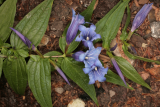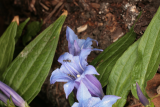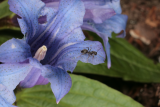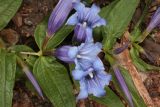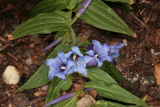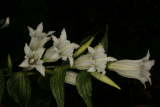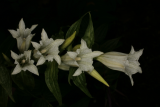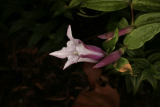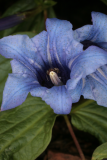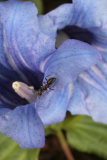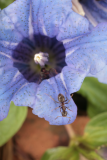Additional notes (click to expand)
Commemorative
This popular genus of garden plants is named after Gentius, King of Illyria (the western Balkan Peninsula) in 181–168 BC. Gentius had a powerful navy of 270 warships (lembi) and like most kings of this era he fought constant wars, fi ghting with the Romans against Macedonia, and then changing sides only to be defeated and brought captive to Rome in 168 BC. The species name of
G. asclepiadea refers to Asclepius, the Greek god of medicine (qv Asclepias tuberosa, p26). Gentius ‘discovered’ the medicinal value of the root of Gentiana lutea according to Dioscorides, who recommends it for animal bites, sprains, healing wounds and (as a pessary) as an abortifacient.
Oakeley, Dr. Henry. (2012). Doctors in the Medicinal Garden. Plants named after physicians. Royal College of Physicians.
link
The species name derives from Asclepius, the Greek god of medicine (Aesculapius in the Roman pantheon), the son of Apollo. He probably existed around 600 BC, but became a Roman god in c. 295 BC. Apollo was the god who kept disease away and Telesphorus, the short person with the woolly hat who accompanies Asclepius in the Royal College of Physicians’ statue, was the god of convalescence. Asclepius was regarded as a ‘hands-on’ physician who intervened with drugs and surgery when a person was ill. His staff, with a single snake twined round it, is the symbol of medicine, and is used as the logo of the British Medical Association and the American Medical Association. The caduceus, two snakes twined round a winged staff, was given to Hermes, the messenger of the gods, by Apollo and is not a medical symbol, although it has been so used in error (Graf, 2009). The mythology of Asclepius is convoluted, and there are several versions. Ovid’s (AD 8) version was that his mother was Coronis, daughter of Phlegyas, king of the Lapiths. Apollo
killed her when he heard she was a lover to someone else. The baby Asclepius, delivered by caesarean section from the dead Coronis as she lay on her burning funeral pyre by the repentant Apollo, was brought up by the centaur Chiron (who also brought up Achilles qv). Asclepius became so skilled that he was able to revive the dead, and Zeus killed him with a bolt of lightning. One version states that this was at the request of Pluto, king of the Underworld, who had become worried that Asclepius might keep everyone alive so there would be no more souls to enter Hades.
Oakeley, Dr. Henry. (2012). Doctors in the Medicinal Garden. Plants named after physicians. Royal College of Physicians.
link
Horticulture
A member of the Gentianaceae family, it is a hardy perennial hailing from the woodlands of central and southern Europe. It has tall, graceful stems with bluegreen leaves and produces tubular, dark blue flowers in late summer. It prefers a shady position in free-draining, damp soil. The roots may rot in cold, wet winter conditions. Once planted, it is best left undisturbed with an annual mulch
of leaf mould. Plants can be propagated by sowing fresh seed in a cold frame or by careful division (CB).
Oakeley, Dr. Henry. (2012). Doctors in the Medicinal Garden. Plants named after physicians. Royal College of Physicians.
link
Nomenclature
Gentius, King of Illyria (the western Balkan Peninsula) in 181–168 BC.
The species name of G. asclepiadea refers to Asclepius, the Greek god of medicine
Oakeley, Dr. Henry. (2012). Doctors in the Medicinal Garden. Plants named after physicians. Royal College of Physicians. p. 71
link
Other use
Named after Gentius, King of Illyria (the western Balkan Peninsula) in 181–168 BC. Gentius had a powerful navy of 270 warships (lembi) and like most kings of this era he fought constant wars, fighting with the Romans against Macedonia, and then changing sides only to be defeated and brought captive to Rome in 168 BC; asclepiadea refers to Asclepius, the Greek god of medicine. Gentius ‘discovered’ the medicinal value of the root of Gentiana lutea according to Dioscorides, who recommends it for animal bites, sprains, healing wounds and (as a pessary) as an abortifacient. Later authors note its bitter taste, and quote Galen as thus indicating its use as a purgative. Culpeper (1649) writes: ... some call it Felwort or Baldmoney. It is ... a notable counterpoison, it opens obstructions, helps the bitings of venomous beasts, and mad dogs, helps digestion, and cleanseth the body of raw humours; our chyrugians [surgeons] use the root in the form of a tent to open the sore, they are also very profitable for ruptures [hernias] or such as are burnt. The root is still used as the bittering agent in Angostura bitters, the basis for a ‘Pink Gin’, and in herbal medicine for everything from malaria to snakebite. It is not the source of Gentian violet, a blue-purple dye, which is derived from coal tar.
Oakeley, Dr. Henry F. (2013). Wellcome Library notes.
link
Geographical distribution
- Asia-Temperate, Western Asia, Iran
- Asia-Temperate, Western Asia, Turkey
- Europe, Eastern Europe, Ukraine
- Europe, Middle Europe, Austria
- Europe, Middle Europe, Czech Republic
- Europe, Middle Europe, Germany
- Europe, Middle Europe, Hungary
- Europe, Middle Europe, Poland
- Europe, Middle Europe, Switzerland
- Europe, Southeastern Europe, Albania
- Europe, Southeastern Europe, Bulgaria
- Europe, Southeastern Europe, Italy
- Europe, Southeastern Europe, Romania
- Europe, Southwestern Europe, France
Gentiana asclepiadea L.
Family: GENTIANACEAEGenus: Gentiana
Species: asclepiadea L.
Common names: Willow Gentian; Milkweed Gentian
Distribution summary: Eurasia
Habit: Perennial
Hardiness: H5 - Hardy; cold winter
Habitat: Woodlands
Garden status: Not currently grown
Reason for growing: Commemorative
